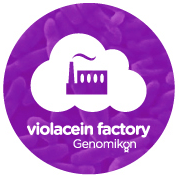 Distributed genetic engineering meets the open web — join in at HealthCamp Boston 2014.
Distributed genetic engineering meets the open web — join in at HealthCamp Boston 2014.
Using the “Genomikon: Violacein Factory” kit with the Synbiota platform, citizen-researchers around the world will work in parallel to engineer a safe strain of E. coli so that it can make violacein on demand.
If through this Open Distributed Genetic Engineering Hack we can identify a DNA design and associated experimental conditions that lower the cost of violacein by half, that would be a stunning scientific accomplishment.
Video and more details after the jump.
By combining hundreds or thousands of people working in parallel with the forces of Genomikon’s Violacein Factory and SYNBIOTA’s #openscience platform, we can try thousands of experimental combinations to arrive at the best genetic assembly for low-cost violacein production.
Will you join us on this challenge?
At HealthCamp Boston, we’ll be hacking DNA under the tutelage of Justin Pahara of Symbiota.
More details:
Research can be slow and medicine can be expensive when it comes to fighting off illnesses. Fortunately, nature has given rise to some incredible creatures that can help.
Violacein is a natural purple compound made by soil-dwelling bacteria that live in the tropics (Chromobacterium violaceum) (Durán et al, 2007). Violacein is the bacteria’s built-in defense, killing any protozoans, like amoeba, that try to eat it.
As a result, violacein has been heralded as a possible treatment against parasites (Matz et al., 2004; Matz and Kjelleberg, 2005). It has also shown promise as a treatment for cancer, particularly leukemia (Ferriera et al., 2004; Carvalho et al., 2006).
***The World Health Organization estimates that 50 million people worldwide suffer from invasive amoebic infections each year, resulting in 40,000 to 100,000 annual deaths (Haque, 2007).But a major problem is violacein’s cost, weighing in today at $356,000.00 per gram. This price barrier is unacceptable, and lives are on the line.
Scientists have determined the metabolic pathway in Chromobacterium violaceum that is able to turn tryptophan (the amino acid that makes you feel sleepy when you eat too much turkey) into violacein. This pathway uses five enzymes, and several different genes code for their production. The difficulty is that the genes can be positioned differently in the DNA molecule to yield the best results. Finding the ideal combination will take many tries, and we can find it faster, together, through a #scienceHack like this.
Can we hack the pathway to Violacein production in order to dramatically decrease its cost and increase its global abundance? We think we can. Let’s prove it together.
Register for HealthCampBoston 2014 and get your #ScienceHack on.
Liked this post? Follow this blog to get more.


